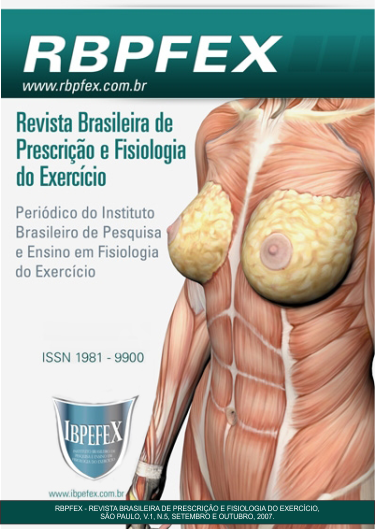Relation of hemodynamics and anthropometrics variables in different classifications of vagal cardic index individuals (VCI)
Abstract
Objective: To ascertain the relationship of age, body mass index (BMI), systolic blood pressure (SBP) and diastolic blood pressure (PAD) and heart rate at rest with vagal cardiac index (VCI) verified through 4 Seconds Exercise Test (T4s). Methodology: Attended in this study 47 males divided between two groups: Sympathotonic (n = 17; 35.12 ± 14.5 years; 178 ± 6.86 cm; 81.47 ± 12.93 kg and 1.11 ± 0.04 to VCI ) and Normal ( n = 30; 24.37 ± 7.45 years; 177.5 ± 7.38 cm; 78.36 ± 10.70 kg and 1.39 ± 0.15, VCI ). The vagal cardiac index (VCI) was determined by digital electrocardiogram during the 4 Seconds Exercise Test. The blood pressure and heart rate were measured after 5 minutes of rest in dorsal decubitus through sphygmomanometer of mercury column and Polar S810 heart rate monitor respectively. Result: When the associated values of BMI, blood pressure at rest and heart rate at rest and chronological age between the two groups (Normal and Sympathotonic), the Sympathotonics showed values of age and BMI significantly higher compared with Normal subjects. In another variables there were not different between groups. Conclusion: we found that Sympathotonic individuals (VCI <1.20) had higher chronological age and BMI compared with Normal individuals (VCI > 1.20).
References
– Almeida, M.B.; Ricardo, D.R.; Araújo, C.G.S. Validação do Teste de Exercício de 4 segundos em Posição Ortostática. Arq Bras Cardiol. 2004;83(2):155-9.
–Almeida, M.B.; Ricardo, D.R.; Araújo, C.G.S. Variabilidade da Freqüência Cardíaca em um Teste de exercício Verdadeiramente Máximo. Rev Socerj. 2005;18(6):534-41.
– Araújo, C.G.; Nóbrega, A.C.; Castro, C.L. Vagal activity: Effect of age,sex and physical activity pattern. Braz J Med Biol Res. 1989;22(7):909-11.
–Araújo, C.G.S.; Ricardo, D.R.; Almeida, M.B. Fidedignidade intra e interdias do teste de exercício de quatro segundos. Ver Bras Med Esporte. 2003;9(5):293-8.
–Castro, C.L.B.; Nóbrega, A.C.L.; Araújo, C.G.S. Testes autonômicos cardiovasculares. Uma Revisão Crítica. Parte II. Arq Bras Cardiol. 1992;59(2):151-8.
–Cerati, D.; Schwartz, P.J. Single cardiac vagal fiber activity, acute myocardial ischemia, and risk for sudden death. Circ Res. 1991;69(5):1389-401.
–Hirsch, J.; Leibel, R.L.; Mackintosh, R.; Aguirre, A. Heart rate variability as a measure of autonomic function during weight change in humans. Am J Physiol. 1991;261(6Pt2):R1418-23.
–Karason, K.; Molgaard, H.; Wikstrand, J.; Sjöström, L. Heart rate variability in obesity and the effect of weight loss. Am J Cardiol. 1999;83(8):1242-7.
–Kleiger, R.E.; Miller, J.P.; Bigger Jr, J.T.; Moss, A.J. Decreased heart rate variability and its association with increased mortality after acute myocardial infarction. Am J Cardiol. 1987;59(4):256-62.
– Maser, R.E.; Lenhard, M.J.; Irgau, I.; Wynn, G.M. Impact of surgically induced weight loss on cardiovascular autonomic function: one-year follow-up. Obesity (Silver Spring). 2007;15(2):364-9.
– Menezes Jr, A.S.; Moreira, H.G.; Daher, M.T. Análise da Variabilidade da Freqüência Cardíaca em Pacientes Hipertensos, Antes e Depois do Tratamento com Inibidores da Enzima Conversora da Angiotensina II. Arq Bras Cardiol. 2004;83(2):165-8.
– Migliaro, E.R.; Contreras, P.; Bech, S.; Etxagibel, A.; Castro, M.; Ricca, R.; e colaboradores. Relative influence of age, resting heart rate and sedentary life style in short- term analysis of heart rate variability. Braz J Med Biol Res. 2001;34(4):493-500.
–Nolan, J.; Batin, P.D.; Andrews, R.; Lindsay, S.J.; Brooksby, P.; Mullen, M.; e colaboradores. Prospective study of heart rate variability and mortality in chronic heart failure:results of the United Kingdom heart failure evaluation and assessment of risk trial (UK-Heart). Circulation. 1998;98(15):1510-6.
–O’Brien, I.A.D.; O’Hare, P.; Corrall, R.J.M. Heart rate variability in healthy subjects : Effectof age and the derivation of normal ranges for tests of autonomic function. Br Heart J. 1986;55:348-54.
–Schroeder, E.B.; Liao, D.; Chambless, L.E.; Prineas, R.J.; Evans, G.W.; Heiss, G. Hypertension, Blood Pressure, and Heart Rate Variability: The Atherosclerosis Risk in Communities (ARIC) Study. Hypertension. 2003;42:1106-11.
–Task Force of the European Society of Cardiology and the North American Society of Pacing and Electrophysiology. Heart rate variability. Standards of measurement, physiological interpretation, and clinical use. Eur Heart J. 1996;17:354-81.
–Teixeira, F.P.; Ricardo, D.R.; Castro, C.L.B.; Araújo, C.G.S. Avaliando a Atividade Vagal Cardiaca na Eletrocardiografia Convencional. Arq Bras Cardiol. 2007;88(4):378-83.
–Zhang, J. Effect of Age and Sex on Heart Rate Variability in Healthy Subjects. J Manipulative Physiol Ther 2007;30(5):374-9.
Authors who publish in this journal agree to the following terms:
- Authors retain the copyright and grant the journal the right of first publication, with work simultaneously licensed under the Creative Commons Attribution License BY-NC which allows the sharing of the work with acknowledgment of the authorship of the work and initial publication in this journal.
- Authors are authorized to enter into additional contracts separately for non-exclusive distribution of the version of the work published in this journal (eg, publishing in institutional repository or book chapter), with acknowledgment of authorship and initial publication in this journal.
- Authors are allowed and encouraged to post and distribute their work online (eg, in institutional repositories or on their personal page) at any point before or during the editorial process, as this can bring about productive change as well as increase impact and impact. citation of published work (See The Effect of Free Access).






